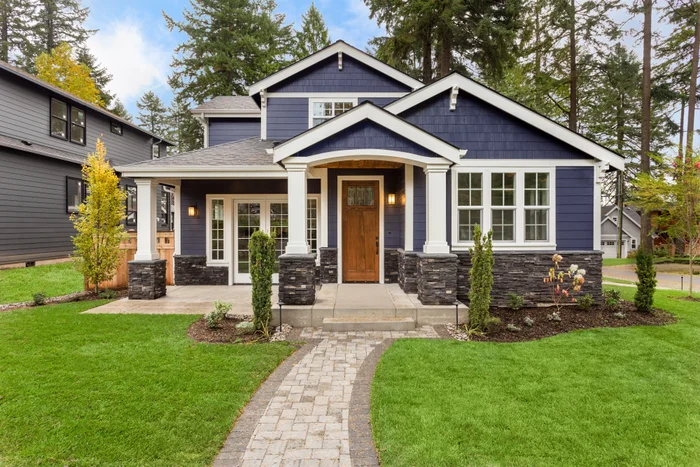
Published 3:32 a.m. ET Oct. 12, 2023
Editorial Note: Blueprint may earn a commission from affiliate partner links featured here on our site. This commission does not influence our editors’ opinions or evaluations. Please view our full advertiser disclosure policy.

Getty Images
Mortgage rates are trending about the same across the board. Here are today’s average mortgage rates:
- 30-year fixed: 7.97%
- 15-year fixed: 7.19%
- 30-year jumbo: 7.93%
*Data accurate as of October 11, 2023, the latest data available.
30-year fixed mortgage rates
Today’s 30-year fixed mortgage rate is 7.97% which is lower than last week’s 8.07%, according to data from Curinos. This is an increase from last month’s 7.66%. Last year around the same time, 30-year fixed rates were 5.99%, which makes today’s rate much higher than it was a year ago.
At the current 30-year fixed rate, you’ll pay about $737 each month for every $100,000 you borrow — down from about $745 last week.
Ready to buy? Compare the best mortgage lenders
15-year fixed mortgage rates
Today’s 15-year fixed mortgage rate is 7.19%, slightly lower than last week’s 7.24%. This is an increase from last month’s 6.81%. Last year around the same time, 15-year fixed rates were 5.42%, which makes today’s rate much higher than it was a year ago.
At the current 15-year fixed rate, you’ll pay about $914 each month for every $100,000 you borrow, down from about $914 last week.
30-year jumbo mortgage rates
Today’s 30-year jumbo mortgage rate is 7.93% which is lower than last week’s 7.97%. This is an increase from last month’s 7.58%. Last year around the same time, 30-year jumbo rates were 5.77%, which makes today’s rate more than 2 percentage points higher than it was a year ago.
At the current 30-year jumbo rate, you’ll pay around $733 each month for every $100,000 you borrow, down from about $736 last week.
Methodology
To determine average mortgage rates, Curinos uses a standardized set of parameters. For conventional mortgages, the calculations are based on an owner-occupied, one-unit property with a loan amount of $350,000. For jumbo mortgages, the loan amount is $750,000. These calculations assume an 80% loan-to-value ratio, a credit score of 740 or higher and a 60-day lock period.
Frequently asked questions (FAQs)
On May 3, 2023, the Federal Reserve announced a third interest rate hike for the year — this time by 25 basis points. While the Fed doesn’t set mortgage rates, this increase in the federal funds rate could lead individual lenders to raise their home loan rates, too.
If you already have a mortgage, how this could affect your monthly payment will depend on if your loan has a fixed or adjustable rate. A fixed rate stays the same over the life of the loan, meaning your payments will never change. An adjustable rate, however, can fluctuate according to market conditions — which means you could see a rise in your monthly payments.
For example, if you take out an ARM for $250,000 with an interest rate of 5.5%, your initial monthly payments would be $1,719. But after the initial period is over, and the ARM switches to a variable rate, your payments could increase if the rate rises. If the rate rose just 25 basis points (5.75%), for instance, your payments would increase to $1,750.
If you’re not planning on keeping a home for a long time, an ARM could be the better option — especially if fixed-rate loans have much higher rates at the time. This is because ARMs tend to have lower rates to start than fixed-rate mortgages, though your rate can increase over time.
While a fixed-rate loan will have the same rate throughout the entire term, an ARM will start with a fixed rate for a set amount of time and then switch to a variable rate that can change for the remainder of your loan term. For example, a 5/1 ARM will have a fixed rate for five years (the “5” in 5/1), then switch to a variable rate that can change once a year (the “1” in 5/1).
Whether a mortgage rate buydown is the right choice for you will depend on your individual circumstances and financial goals. If you plan to stay in the home for a long period of time and can afford to pay for the buydown, it could make sense. But if you know you’ll move or refinance your mortgage before you break even on the cost of the buydown versus the lower monthly payments, then buying down your rate might not be worth it.
Buying down your rate can be permanent or temporary, which will impact the overall cost. A permanent buydown is also known as purchasing mortgage discount points — for each point, you’ll typically pay 1% of the loan amount in return for 0.25% off your rate.
Temporary buydowns, on the other hand, will reduce your interest rate to a certain point, and it will then increase each year until you hit the original rate. Some common temporary options are 2-1 and 1-0 terms, with the first number being how much your rate is reduced in the first year and the second number being the reduction for the following year. Unlike discount points that are paid for by the buyer, this type of buydown can be paid for by the lender, seller or homebuilder.
Blueprint is an independent publisher and comparison service, not an investment advisor. The information provided is for educational purposes only and we encourage you to seek personalized advice from qualified professionals regarding specific financial decisions. Past performance is not indicative of future results.
Blueprint has an advertiser disclosure policy. The opinions, analyses, reviews or recommendations expressed in this article are those of the Blueprint editorial staff alone. Blueprint adheres to strict editorial integrity standards. The information is accurate as of the publish date, but always check the provider’s website for the most current information.









